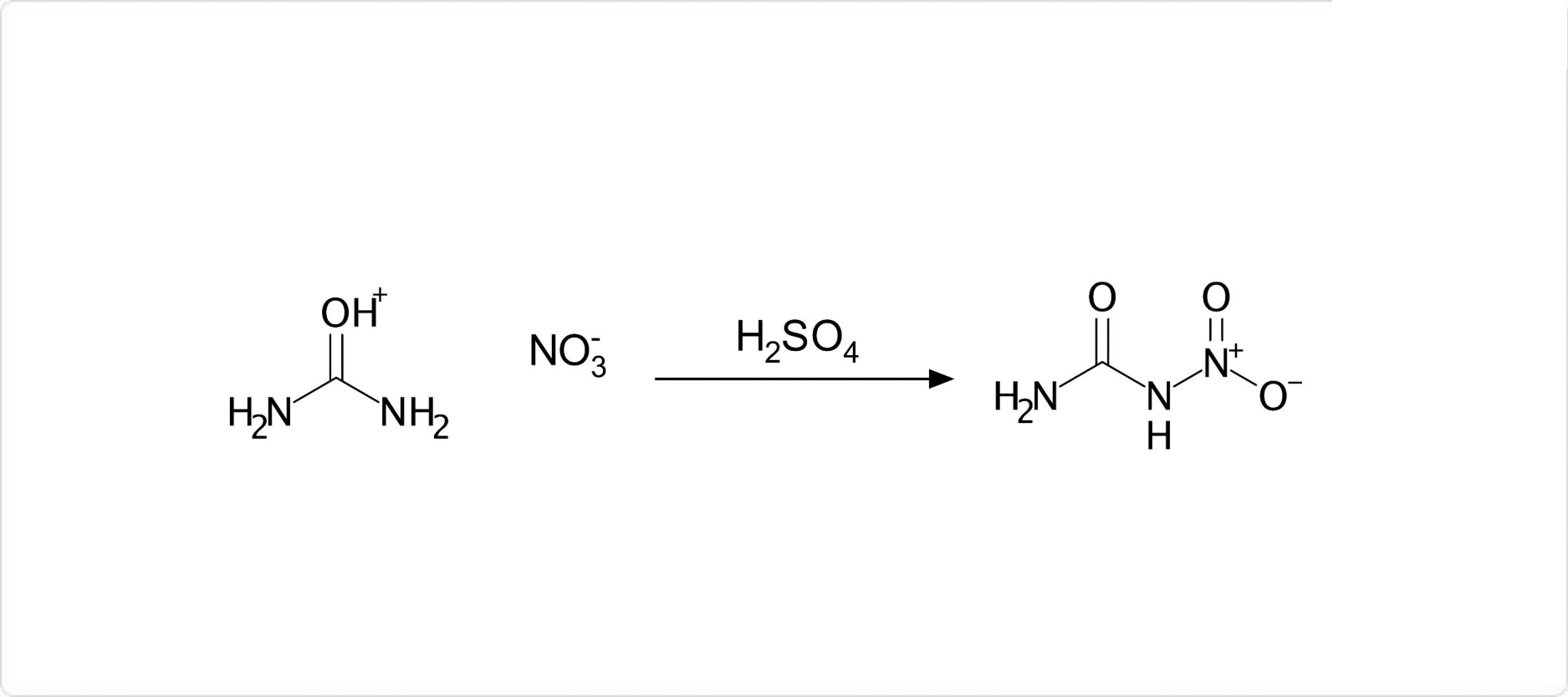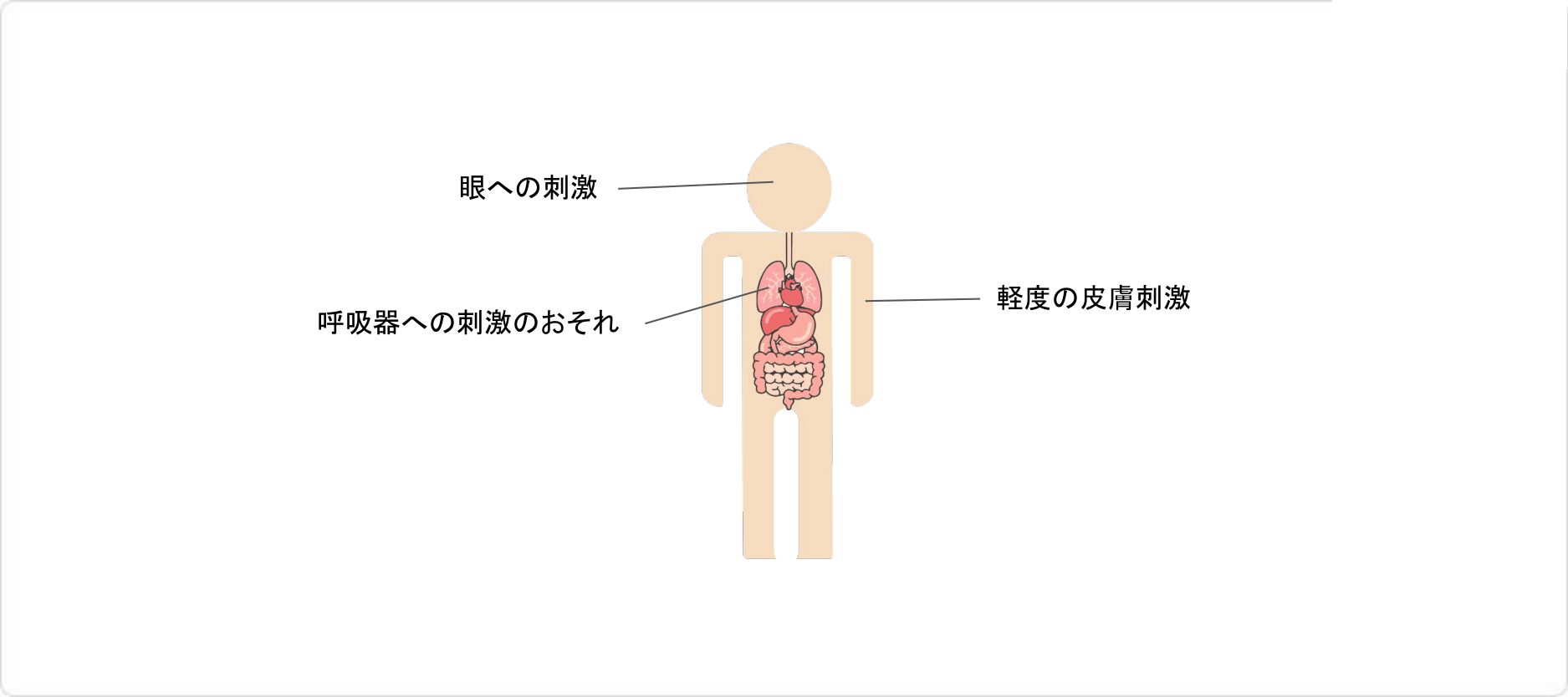-
種類
硝酸尿素は主に研究開発用試薬製品として販売されています。爆発性のある物質であるため、通常は約25%水湿潤品として販売されます。実験室で取り扱いやすい容量で提供されており、25gなどの容量の種類が主流です。
-
性質
硝酸尿素は、分子量123.068、融点152℃ (分解) であり、常温での外観は白色結晶です。水溶液中では尿素を遊離して酸性を示します。熱水に溶けやすく、硝酸には溶けにくいです。
吸湿性及び潮解性はありませんが、炭酸カルシウムなどの無機塩が混合すると吸湿性が大きくなります。密度は1.59g/mL、水への溶解度は9.30g/100g (0℃) 、エタノールへの溶解度は14.2±0.1mg/mLです。エーテル、クロロホルム、ベンゼンには不溶です。
-
解説
硝酸尿素,硝酸 HNO3 と尿素 CH4NO とが結合した尿素複塩の一つ。化学式 HNO3 ・CO ( NH2 ) 2 。白色の結晶で,融点 (分解) 152℃。熱や衝撃で爆発する。混合爆薬として用いる。
-
用途
爆薬増感剤、化学肥料、有機試薬
-
説明
Urea nitrate, is a colorless crystal shipped with not less than 20% water by mass. It is a dangerous fire and explosion risk, and is slightly soluble in water. It decomposes at 305.6°F (152°C). The four-digit UN identification number is 1357. It is used in the manufacture of explosives and urethane.
-
化学的特性
Colorless crystals. Decomposes at
152C. Slightly soluble in water; soluble in alcohol.
-
使用
As sensitizer for explosives; fertilizer; organic reagent; manufacture of urethane.
-
一般的な説明
A crystalline compound arising from the neutralization of urea with nitric acid. Melting point 152°C. Slightly soluble in water. Soluble in alcohol. Primary hazard is blast of an instantaneous explosion, not flying projectiles or fragments.
-
空気と水の反応
Easily ignited. Burns very vigorously to generate toxic oxides of nitrogen. Slightly soluble in water.
-
反応プロフィール
UREA NITRATE is explosive when left in dry state. Wetting reduces possibility of explosion but may explode under prolonged exposure to heat or fire, even when wet. Urea nitrate reacts with strong oxidizer such as perclorates and hypochlorites. With hypochlorites Urea nitrate forms a compound nitrogen trichloride which explodes spontaneously in air (J. Am. Chem. Soc. 63:3530-32). Organic nitrates may explode when shocked, exposed to heat or flame or by spontaneous chemical reaction. Urea nitrate must be stored in a cool, ventilated place, away from acute fire hazards and easily oxidized materials. Also reacts violently with Al; BP; cyanides; esters; PN2H; P; NaCN; SnCl2; sodium hypophosphite; thiocyanates. Dangerous disaster hazard due to fire and explosion hazard. On decomposition, they emit toxic fumes. They are powerful oxidizing agents which may cause violent reaction with reducing materials. Nitrates should be protected carefully in storage. (SAX and Lewis, 1987) p.664. Decomposition is catalyzed by the presence of heavy metals such as lead or iron in trace amounts [Bretherick, 1995, pg. 201]. Produces toxic oxides of nitrogen during combustion. Decomposed with explosive evolution of gas during the evaporation of an alkaline solution. [Bretherick, 1995, p. 201].
-
健康ハザード
Fire may produce irritating, corrosive and/or toxic gases.
-
火災危険
MAY EXPLODE AND THROW FRAGMENTS 1600 meters (1 MILE) OR MORE IF FIRE REACHES CARGO.
-
使用用途
硝酸尿素の主な使用用途は、爆薬増感剤、爆薬、脱硫剤、有機試薬です。
1. 爆薬
硝酸尿素を広義に含む、ベースの爆薬は、即興爆発装置 (IED) として知られている物質です。尿素および硝酸はともに肥料産業において大量生産されています。これらの入手の容易さと硝酸尿素の合成の容易さから、現代の紛争においてIEDが製造使用されるという事態が起こっています。
2. その他
硝酸尿素は窒素原子を含むため、窒素肥料としての実用化が検討されたこともありますが、酸性度が高すぎるため現在のところは実用化に至っていません。また、種々の物質との反応性があるため、有機試薬としても用いられます。
-
化学反応

硝酸尿素を用いたニトロ尿素の合成
硝酸尿素は、化学反応性の高い物質です。加熱すると激しく燃焼又は爆発することがあり、衝撃、摩擦又は振動によって爆発的に分解することがあります。また、多くの化学物質と激しく反応し、火災や爆発の危険をもたらす物質です。
危険有害な分解生成物は、一酸化炭素、二酸化炭素、窒素酸化物などです。これらの性質により、熱、火花、裸火、高温、喫煙などの着火源との接触は避けるべきとされます。また、硝酸尿素は、濃硫酸との反応によりニトロ尿素を生成します。
-
法規制情報
前述の火薬としての危険性により、硝酸尿素は法令によって規制を受ける物質です。火薬類取締法では第2条火薬類に指定されており、船舶安全法では、危規則第3条危険物告示別表第1火薬類です。
航空法では輸送禁止であり、 港則法では施行規則第12条危険物告示火薬類に指定されています。主に輸送の上で注意が必要な物質です。
参考文献
-
有害性

図3. 硝酸尿素の人体への有害性
硝酸尿素は、物理的危険性や人体への有害性がある物質です。GHS分類では下記のように分類されています。
- 火薬類: 等級1.1
- 皮膚腐食性・刺激性: 区分3
- 眼に対する重篤な損傷・眼刺激性: 区分2B
- 特定標的臓器毒性 (単回ばく露) : 区分3 (気道刺激性)
取り扱いの際は局所排気装置を設置し、保護衣や保護メガネなどの適切な個人用保護具を使用することが必要です。
3. 硝酸尿素の法規制情報
-
安全性プロファイル
A mild irritant.
Flammable when exposed to heat or flame.
The dry nitrate may explode when heated.
The presence of heavy metals (e.g., lead,
iron) catalyzes the thermal decomposition of
urea nitrate. When heated to decomposition
it emits toxic fumes of NOx.
-
純化方法
Crystallise it from dilute HNO3 or EtOH (m 157-158o) and dry it in a vacuum over P2O5. [Beilstein 3 H 54, 3 I 25, 3 II 45, 3 III 105, 3 IV 94.]



